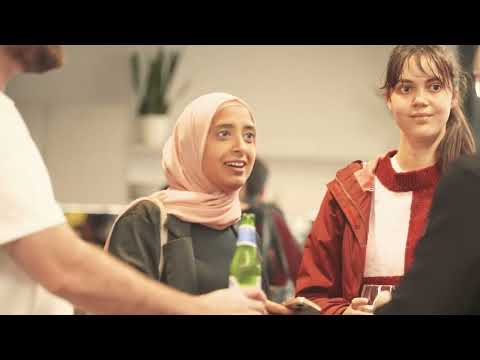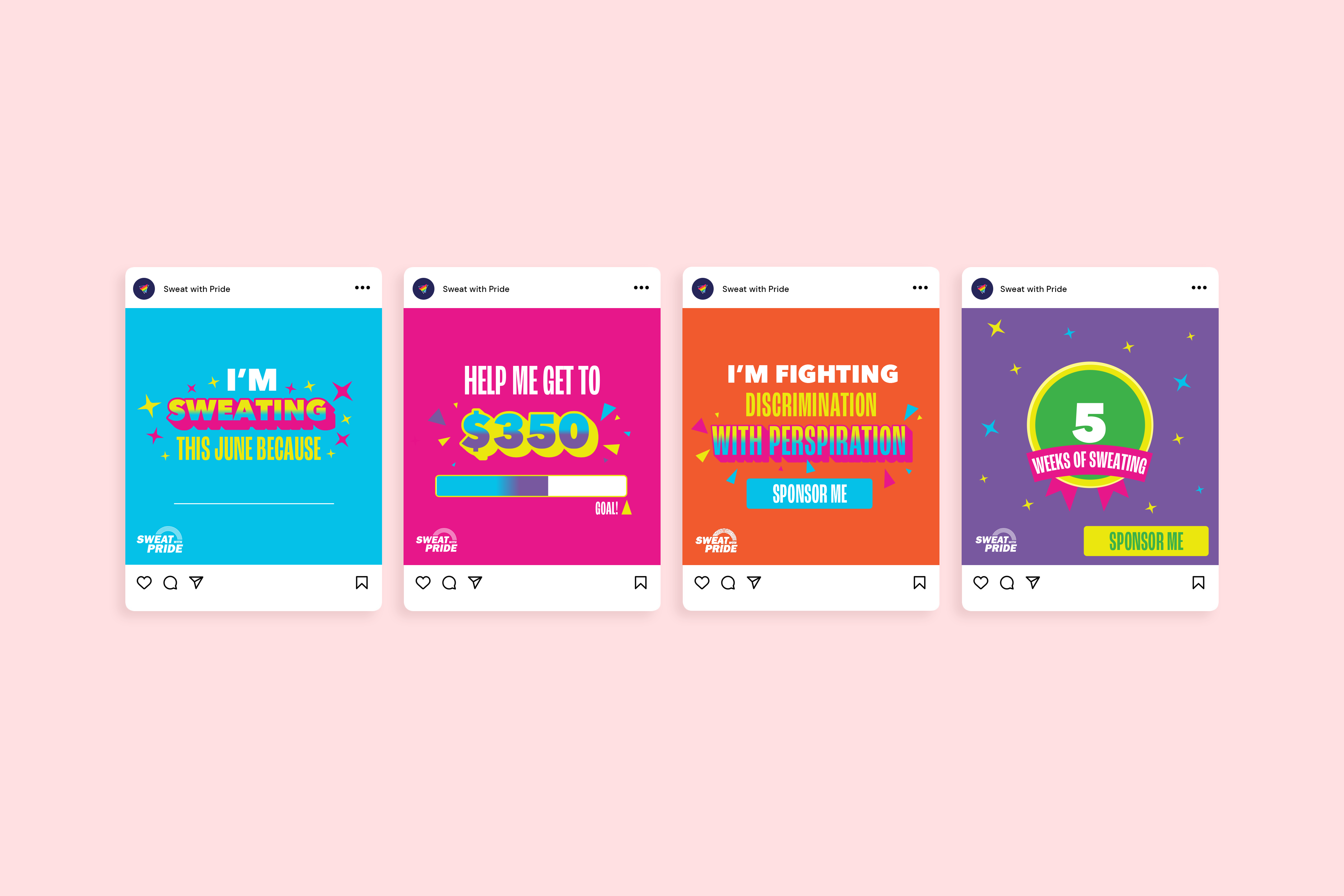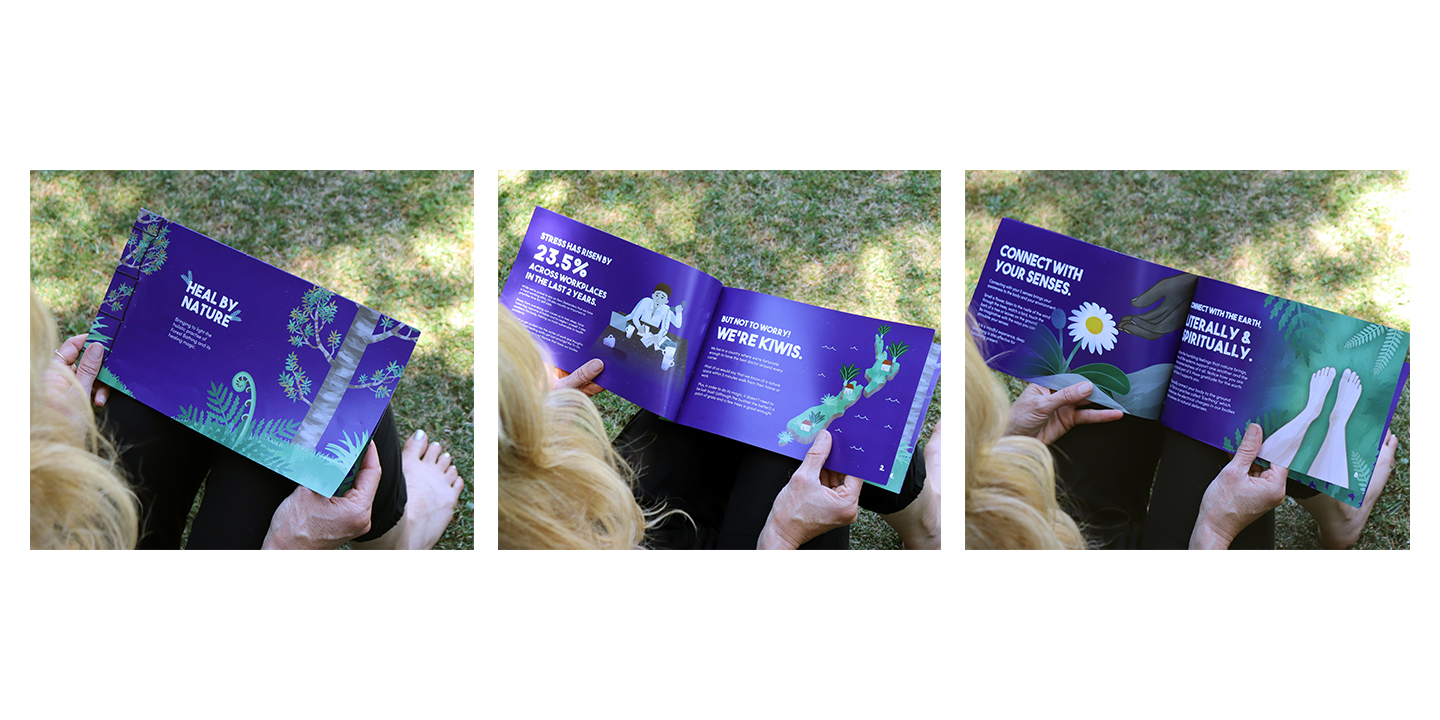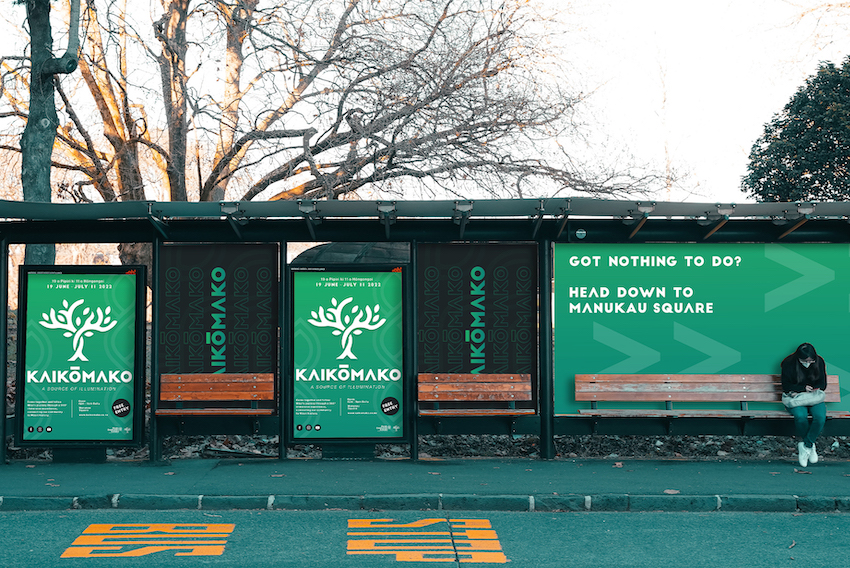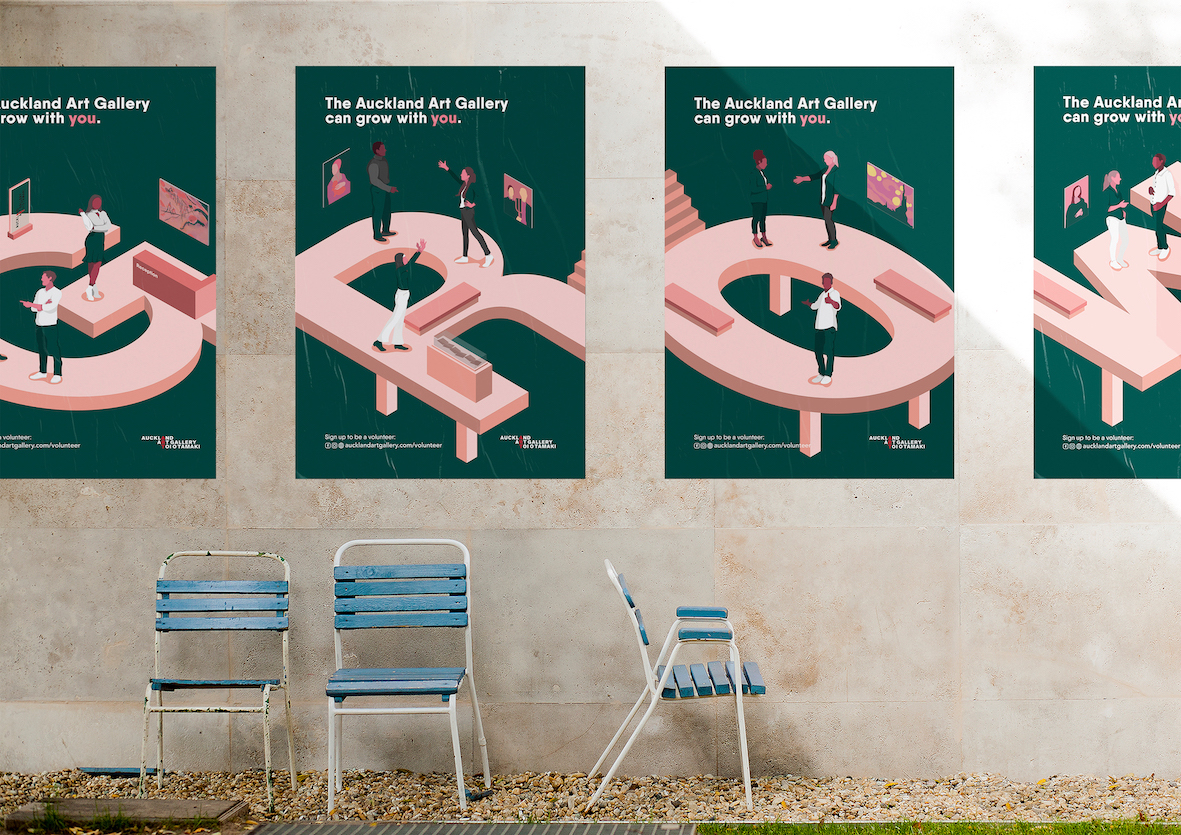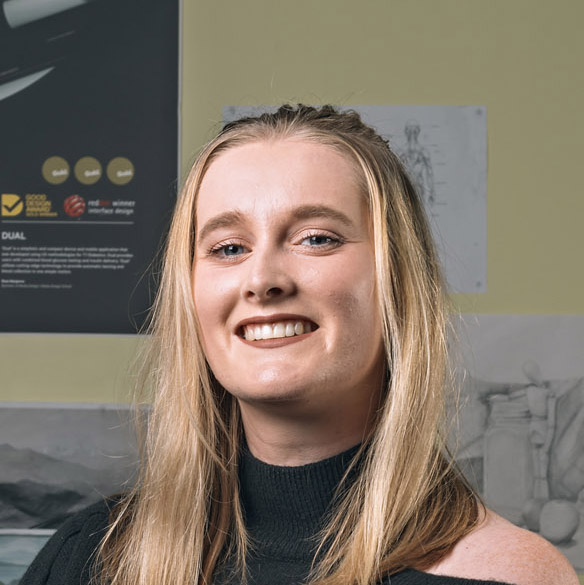What is the Bachelor of Media Design?
The Bachelor of Media Design programme is your gateway into the world of design. This course spends the first year introducing you to the principles and essentials every designer should know, and gives you a taste of the three major areas of Graphic Design, Motion Design and Interactive (UX) Design. From there you choose your major for second and third year where you will work on live briefs with real companies, and get everything you need to excel in your chosen specialty.
Not sure what the difference is between Graphic, Motion and Interactive design? Read more below
Choose your Major
After getting to grips with Design in Year 1, you are able to choose your path through years 2 and 3 with a major in either Graphic Design, Motion Design or Interactive (UX) Design.
What is Graphic Design?
Graphic Design teaches you how to communicate using text, image and form to make visual connections and craft the seeds of ideas and information into meaningful interactions.
Design shapes the world around us and the demand for designers is set to grow in the coming years. Visual communication is an important aspect of almost every industry, with those who build their career in the field in the privileged position of having choices about where and how they want to work. Creative types dreaming of following their passion can have the best of both worlds, gaining an abundance of experience in the field, as well as coveted skills along the way.
By the end of your third year at MDS, you will have designed, constructed and documented an industry-standard body of work that represents your perspective as an emerging professional designer.
What is Motion Design?
Motion design is the process of giving life to otherwise static graphics and images through animation. In essence, it involves giving movement to traditional graphic design elements like text and logs, albeit with less emphasis on storytelling. By incorporating the element of time into the creation process it adds a new dimension to graphics.
Bring design to life
Making text, illustrations and images move is the specialty of the Motion Graphics Designer. This truly unique art form can be found in numerous elements of digital design, including music videos, promotional videos, television commercials, and in films. This course includes learning key technical skills such as 2D and 3D animation, visual effects, composition, image manipulation and text choreography to give you the experience and evidence of working to a client brief needed to land a job in a dynamic and exciting agency and production environment.
What is Interactive Design?
The Interactive Design major prepares you for the technical demands of the web and mobile development industries. As you move along the course, you’ll experiment with a variety of interactive and dynamic design theories and be immersed in fundamental digital design processes, such as front-end web development, interactive programming, and content management systems.
What is interactive media?
Interactive media typically refers to digital products and services that require user input in order to complete certain tasks and actions. Interactive media may combine a range of visual elements like text, images, menus and animations. How well these elements are combined greatly determine the ease and accessibility of the user experience.
Course Outline
Dive head-first into the field with an introduction to graphic design disciplines, historical influences and the theories, principles and processes of graphic design. Advanced ideation and creative problem-solving strategies are also covered in this incredibly thorough course. Theory is nothing without practical experience, and with Media Design School you'll be immersed into a project-based environment to put your knowledge into practice, ensuring you'll develop technical solutions to design briefs.
| Component Name | Credits | Toggle |
|---|---|---|
|
Design Theory
|
10
|
|
|
Students begin to develop a common vocabulary and understanding of the major motivations and concerns of media designers, enabling them to collaborate across majors in interdisciplinary teams to develop effective media designs in future joint projects such as Interdisciplinary Group Project.
Level 5
BMD1R1
PC3994
|
||
|
Design Studio
|
20
|
|
|
Students put theories and principles learnt in Design Principles (BMD1R1) into practice. They are introduced to a range of analogue tools and creative problem-solving methods using a combination of guided class exercises, group work, class discussions and self-directed investigative tasks. Students develop creative solutions in response to briefs, critique and reflect on each others work within a workshop environment.
Level 5
BMD1R2
PC3994
|
||
|
Contextual Studies 1
|
10
|
|
|
In combination with other components, students are introduced to the idea of using a critical position in response to contextual study to develop imaginative and socially relevant approaches to visual communication. Students also acquire the knowledge and skill to identify the content, media, processes and context of a chosen subject and relate it to contemporary practices.
Level 5
BMD1R3
PC3994
|
||
|
Photographic Studies
|
10
|
|
|
Students focus on developing fundamental technical photographic skills and identify contexts for the work to operate. Students can use photography to explore concepts and contexts, or develop their own subject matter and approach. A series of images will be created as a visual response to the exploration of a predetermined subject and position.
Level 5
BMD1R4
PC3994
|
||
|
Digital Image Foundation
|
10
|
|
|
Digital Image Foundation focuses on providing a basic technical vocabulary and skillset for digital image making, providing a foundation for effective practices in all media design disciplines. Through practice exercises students are introduced to industry-standard software packages used in the production of digital imagery such as Photoshop and Illustrator.
Level 5
BMD1R5
PC3994
|
||
|
Interdisciplinary Design Foundation
|
30
|
|
|
Students independently implement a multi-part interdisciplinary project integrating practices from all majors. The project is carried out within tight technical and creative limitations, giving students practical experience working in a commercial design environment. Independent and reflective thinking, personal responsibility, time management and practical skills are developed using a project-based learning approach.
Level 5
BMD1R6
PC3994
|
||
|
Graphic Design Principles of Practice 1
|
10
|
|
|
Students are introduced to graphic design disciplines, historical influences and the theories, principles and processes of graphic design. Some of the topics include market research, typography, brand identity and wayfinding. Advanced ideation & creative problem-solving strategies, including methods for generating & evaluating effective concepts of graphic design communication, are also incorporated. Students also strengthen their abilities to prepare effective convincing briefs.
Level 5
BMD1GD1
PC3994
|
||
|
Graphic Design Studio 1
|
20
|
|
|
Classes focus on developing creative and technical solutions in response to graphic design briefs through technical demonstrations and practical work.
Level 5
BMD1GD2
PC3994
|
||
Year 2
Through a combination lectures, group work and discussions you are introduced to graphic design from a historical viewpoint. You'll develop a vocabulary and understanding of the concerns of graphic design, to better analyse work and respond to creative briefs. This knowledge is put into practice as part of the studio component of your graphic design degree.
| Component Name | Credits | Toggle |
|---|---|---|
|
Creative Media Strategies
|
15
|
|
|
Students are introduced to different areas of marketing communications, the media involved, the concept of creative advertising, the creative brief and the importance of ideas and insights in enabling integrated and transmedia communication.
Level 6
BMD2R1
PC3994
|
||
|
Professional and Academic Practice 1
|
15
|
|
|
This component introduces students to the subjects of project management, interpersonal communication and scholarly investigation. Students are encouraged to examine assumptions and personal biases that effect their investigative practice. Industry guests also provide live case studies to promote student engagement and develop authentic dialogues. Various presentation formats, strategies and conventions are presented.
Level 6
BMD2R2
PC3994
|
||
|
Contextual Studies 2
|
10
|
|
|
This component introduces students to a specific contemporary issue in Media Design. Learning will be supported with guest lectures, critique sessions and reading groups introducing students to multiple perspectives, encouraging independent critical thinking and helping them develop in depth dialogues with the topic.
Level 6
BMD2R3
PC3994
|
||
|
Special Topic Project
|
20
|
|
|
Students engage in an investigative project that effectively explore concepts and contextual knowledge. The projects can be weighted differently depending on the goals of the student. Two project types are available: Interdisciplinary Project, for students who want to develop knowledge across majors in a practical project; and Specialist Investigation, for students who choose to deepen knowledge within their own major.
Level 6
BMD2R4
PC3994
|
||
|
Principles of Practice 2
|
20
|
|
|
Students gain advanced knowledge of graphic design theory and are introduced to deeper understanding of graphic design applications, ethics and sustainability. Students continue to develop a common vocabulary and understanding of the major concerns of graphic design enabling them to better analyse and implement work.
Level 6
BMD2GD1
PC3994
|
||
|
Graphic Design Studio 2
|
40
|
|
|
Students explore practical approaches to providing a design-led solution. Creative briefs are delivered in a studio environment and students develop a better understanding to work confidently, individually and as a team. This provides students with a holistic understanding of the creative process.
Level 6
BMD2GD2
PC3994
|
||
Year 3
Through work on your final portfolio, reflect on your own specific strengths and weaknesses, self-promotional skills and develop awareness of how you could fit into industry as a professional. This helps to prepare you for the Capstone Project: Practice-based Inquiry and future employment.
| Component Name | Credits | Toggle |
|---|---|---|
|
Professional and Academic Practice 2
|
15
|
|
|
In this component students continue to develop the knowledge and skills necessary to undertake postgraduate studies or pursue a career of life-long learning, critical thinking and inquiry within their professional domain. Students are introduced to portfolio development strategies, studio management theory and small business concerns. They also extend their understanding of project management, creative strategies and academic practice.
Level 7
BMD3R1
PC3994
|
||
|
Interdisciplinary Group Project
|
30
|
|
|
This component consists of a single major interdisciplinary group project, where students collaborate to conceive and produce an integrated media marketing campaign. They are organised into groups comprising members from across the different major streams and are provided with a client brief.
Level 7
BMD3R2
PC3994
|
||
|
Graphic Design Portfolio
|
15
|
|
|
Portfolio development focuses on developing students’ insight into their own specific practice, their self-promotional skills, and awareness of how, and where, they could fit into industry as professionals, preparing them for their Capstone Project: Practice-based Inquiry (BMD3GD2) and future employment or self directed practitioner or further study.
Level 7
BMD3GD1
PC3994
|
||
|
Graphic Design Capstone Project: Practice-based Inquiry
|
60
|
|
|
Students design, construct and document a body of work that addresses the proposal for an end-of-year exhibition. Students will be able to collaborate in pairs or on team projects as long as their role in the project and their specific individual aims are clearly expressed in their project brief. This final body of work will represent the culmination of the degree process and should also represent the students’ perspective as emerging professional designers.
Level 7
BMD3GD2
PC3994
|
||
Year 2
Build on the knowledge you gained in the first year with an emphasis on the production of innovative video and motion graphic campaigns for TV commercials, music videos and logo animation. Acquiring the essential skills in communication, pitching, and collaboration are a critical part of the year, as well as strategies and methods to go out on your own.
| Component Name | Credits | Toggle |
|---|---|---|
|
Creative Media Strategies
|
15
|
|
|
Students are introduced to different areas of marketing communications, the media involved, the concept of creative advertising, the creative brief and the importance of ideas and insights in enabling integrated and transmedia communication.
Level 6
BMD2R1
PC3994
|
||
|
Professional and Academic Practice 1
|
15
|
|
|
This component introduces students to the subjects of project management, interpersonal communication and scholarly investigation. Students are encouraged to examine assumptions and personal biases that effect their investigative practice. Industry guests also provide live case studies to promote student engagement and develop authentic dialogues. Various presentation formats, strategies and conventions are presented.
Level 6
BMD2R2
PC3994
|
||
|
Contextual Studies 2
|
10
|
|
|
This component introduces students to a specific contemporary issue in Media Design. Learning will be supported with guest lectures, critique sessions and reading groups introducing students to multiple perspectives, encouraging independent critical thinking and helping them develop in depth dialogues with the topic.
Level 6
BMD2R3
PC3994
|
||
|
Special Topic Project
|
20
|
|
|
Students engage in an investigative project that effectively explore concepts and contextual knowledge. The projects can be weighted differently depending on the goals of the student. Two project types are available: Interdisciplinary Project, for students who want to develop knowledge across majors in a practical project; and Specialist Investigation, for students who choose to deepen knowledge within their own major.
Level 6
BMD2R4
PC3994
|
||
|
Principles of Practice 2
|
20
|
|
|
Students are provided advanced knowledge of motion design theory as well as experience with academic writing and critical thinking. Students consider motion design from a historic viewpoint for the purpose of drawing inspiration and enhancing understanding of theory and concept. Contextual knowledge of specific areas within motion design such as broadcast design, advertising and film will be used to introduce students to the formal theories and techniques.
Level 6
BMD2MD1
PC3994
|
||
|
Motion Design Studio 2
|
40
|
|
|
Projects linked to creative briefs set in Creative Media Strategies (BMD2R1) enable students to respond with motion design solutions that work in conjunction with other majors. This provides students with holistic understanding of the creative process.
Level 6
BMD2MD1
PC3994
|
||
Year 3
The final year covers essential business methods, research methods and project management before an interdisciplinary group project challenges you to synthesise your knowledge and skills as part of a creative team. You will also embark on a half-year, practice-based investigation of motion graphics.
| Component Name | Credits | Toggle |
|---|---|---|
|
Professional and Academic Practice 2
|
15
|
|
|
In this component students continue to develop the knowledge and skills necessary to undertake postgraduate studies or pursue a career of life-long learning, critical thinking and inquiry within their professional domain. Students are introduced to portfolio development strategies, studio management theory and small business concerns. They also extend their understanding of project management, creative strategies and academic practice.
Level 7
BMD3R1
PC3994
|
||
|
Interdisciplinary Group Project
|
30
|
|
|
This component consists of a single major interdisciplinary group project, where students collaborate to conceive and produce an integrated media marketing campaign. They are organised into groups comprising members from across the different major streams and are provided with a client brief.
Level 7
BMD3R2
PC3994
|
||
|
Motion Design Portfolio
|
15
|
|
|
Level 7
BMD3MD1
PC3994
|
||
|
Motion Design Capstone Project: Practice-based Inquiry
|
60
|
|
|
Level 7
BMD3MD2
PC3994
|
||
Year 2
Through a combination of lectures, group work and discussions you are introduced to interactive design from a historical viewpoint. You'll also develop a vocabulary and understanding of the concerns of interactive design to better analyse work and respond to creative briefs. This knowledge is put into practice as part of the studio component.
| Component Name | Credits | Toggle |
|---|---|---|
|
Creative Media Strategies
|
15
|
|
|
Students are introduced to different areas of marketing communications, the media involved, the concept of creative advertising, the creative brief and the importance of ideas and insights in enabling integrated and transmedia communication.
Level 6
BMD2R1
PC3994
|
||
|
Professional and Academic Practice 1
|
15
|
|
|
This component introduces students to the subjects of project management, interpersonal communication and scholarly investigation. Students are encouraged to examine assumptions and personal biases that effect their investigative practice. Industry guests also provide live case studies to promote student engagement and develop authentic dialogues. Various presentation formats, strategies and conventions are presented.
Level 6
BMD2R2
PC3994
|
||
|
Contextual Studies 2
|
10
|
|
|
This component introduces students to a specific contemporary issue in Media Design. Learning will be supported with guest lectures, critique sessions and reading groups introducing students to multiple perspectives, encouraging independent critical thinking and helping them develop in depth dialogues with the topic.
Level 6
BMD2R3
PC3994
|
||
|
Special Topic Project
|
20
|
|
|
Students engage in an investigative project that effectively explore concepts and contextual knowledge. The projects can be weighted differently depending on the goals of the student. Two project types are available: Interdisciplinary Project, for students who want to develop knowledge across majors in a practical project; and Specialist Investigation, for students who choose to deepen knowledge within their own major.
Level 6
BMD2R4
PC3994
|
||
|
Principles of Practice 2
|
20
|
|
|
In this component, students develop their own parameters for significant studio projects by interpreting open briefs, set briefs are provided for smaller tasks. Artefacts reflecting these briefs are developed in the studio component. Students experiment with a variety of interactive and dynamic design theories, in concept and through reflection on practical work done in studio.
Level 6
BMD2ID1
PC3994
|
||
|
Interactive Studio 2
|
40
|
|
|
Projects and exercises can be linked to creative briefs set in Creative Media Strategies (BMD2R1). Students can interpret these and respond with interactive design and technical proposals, developed in Interactive Design Principles of Practice 2 (BMD2ID1), which can be implemented in this component. Solutions can dovetail with projects from other majors to produce integrated campaigns, providing students with holistic understanding of the creative process.
Level 6
BMD2ID2
PC3994
|
||
Year 3
Through work on your final portfolio, reflect on your specific strengths and weaknesses, self-promotional skills and develop awareness of how you could fit into industry as a professional. This helps to prepare you for your final capstone project as well as the realities of future employment.
| Component Name | Credits | Toggle |
|---|---|---|
|
Professional and Academic Practice 2
|
15
|
|
|
In this component students continue to develop the knowledge and skills necessary to undertake postgraduate studies or pursue a career of life-long learning, critical thinking and inquiry within their professional domain. Students are introduced to portfolio development strategies, studio management theory and small business concerns. They also extend their understanding of project management, creative strategies and academic practice.
Level 7
BMD3R1
PC3994
|
||
|
Interdisciplinary Group Project
|
30
|
|
|
This component consists of a single major interdisciplinary group project, where students collaborate to conceive and produce an integrated media marketing campaign. They are organised into groups comprising members from across the different major streams and are provided with a client brief.
Level 7
BMD3R2
PC3994
|
||
|
Interactive Design Portfolio
|
15
|
|
|
Portfolio development focuses on developing students’ insight into their own specific strengths and weaknesses, their self-promotional skills, and awareness of how they could fit into industry as professionals, preparing them for their Capstone Project: Practice-based Inquiry (BMD3ID2) and future employment.
Level 7
BMD3ID1
PC3994
|
||
|
Interactive Design Capstone Project: Practice-based Inquiry
|
60
|
|
|
Students design, construct and document a body of work that addresses the proposal for an end-of-year exhibition. Students will be able to collaborate in pairs or on team projects as long as their role in the project and their specific individual aims are clearly expressed in their project brief. This final body of work will represent the culmination of the degree process and should also represent the students’ perspective as emerging professional designers.
Level 7
BMD3ID2
PC3994
|
||
Careers & Industry
The Bachelor of Media Design provides you with everything you need to pursue a career in design, regardless of the discipline you major in. Our graduates have gone onto have successful careers, both in the freelance world as well as working for design studios, advertisers or large companies.
Creative Director
Major in Graphic Design
Brand Designer
Major in Graphic Design
Print Designer
Major in Graphic Design
Animation Director
Major in Motion Design
Motion Graphics Designer
Major in Motion Design
Broadcast Designer
Major in Motion Design
Head of UX Design
Major in Interactive (UX) Design
UI Designer
Major in Interactive (UX) Design
UX Designer
Major in Interactive (UX) Design
Course Requirements
| NCEA | You are advised to take a combination of traditional and digital art subjects (these could include Art, Digital Technologies, Digital and Visual Communications, or Ngā Toi). |
| CIE | You are advised to take at least one Art-related subject. |
| IB | Your IB Diploma must include an arts-related subject. A portfolio showcasing your design skills is also required. |
| Special Entry, Discretionary Entry and Cross Credits | You may be eligible for discretionary entrance if you have: - Excellence Endorsement(s) in Mathematics, Physics, Computing or Technology subjects at Level 2, AND - Literacy and Numeracy requirements (i.e.: 10 credits in Maths at Level 1 and 10 credits in English at Level 2 (5 reading/5 writing)) You may be eligible for Special Admission if you: - Are over 20 years old - Have relevant experience or can demonstrate mathematic knowledge Click the title for more info! |
| International Students | To apply for this degree, you'll need a minimum qualification of NCEA University Entrance or CIE (University of Cambridge International Examination) or IB (International Baccalaureate) or equivalent overseas secondary school qualification or have completed one year of tertiary study from recognised institution. Please Note: Entry requirement may vary based on your country of citizenship. Please refer to our International Page for entry requirements at mediadesignschool.com/international-students. If you country is not on the list, please email international@mediadesignschool.com for further information. All international students must be 18 years of age when the programme commences (on- campus or online). International applicants can start their application before they turn 18 years of age. |
| Quotas | Please note, quotas may apply to some programmes. Where demand exceeds the number of available places, applicants who meet entry requirements will be admitted on a first-come-first-served basis. |
| NCEA |
| You are advised to take a combination of traditional and digital art subjects (these could include Art, Digital Technologies, Digital and Visual Communications, or Ngā Toi). |
| CIE |
| You are advised to take at least one Art-related subject. |
| IB |
| Your IB Diploma must include an arts-related subject. A portfolio showcasing your design skills is also required. |
| Special Entry, Discretionary Entry and Cross Credits |
| You may be eligible for discretionary entrance if you have: - Excellence Endorsement(s) in Mathematics, Physics, Computing or Technology subjects at Level 2, AND - Literacy and Numeracy requirements (i.e.: 10 credits in Maths at Level 1 and 10 credits in English at Level 2 (5 reading/5 writing)) You may be eligible for Special Admission if you: - Are over 20 years old - Have relevant experience or can demonstrate mathematic knowledge Click the title for more info! |
| International Students |
| To apply for this degree, you'll need a minimum qualification of NCEA University Entrance or CIE (University of Cambridge International Examination) or IB (International Baccalaureate) or equivalent overseas secondary school qualification or have completed one year of tertiary study from recognised institution. Please Note: Entry requirement may vary based on your country of citizenship. Please refer to our International Page for entry requirements at mediadesignschool.com/international-students. If you country is not on the list, please email international@mediadesignschool.com for further information. All international students must be 18 years of age when the programme commences (on- campus or online). International applicants can start their application before they turn 18 years of age. |
| Quotas |
| Please note, quotas may apply to some programmes. Where demand exceeds the number of available places, applicants who meet entry requirements will be admitted on a first-come-first-served basis. |
As an international student, you'll need to prove you have sufficient English language skills in order to complete this course. We'll be looking for Academic IELTS overall score of 6.0 (minimum) with no band less than 5.5, or equivalent test result.
We accept a range of internationally recognised English Language proficiency test. Find out more on the NZQA website or download the NZQA list HERE.
Your portfolio is a selection of work that shows your skills and talents. It introduces you and your ideas, and shows us you have the creativity and imagination to be a student at Media Design School. There are no strict rules about what you should include in your portfolio. As a guide, it should include a range of 8 - 12 pieces of your best works that represent who you are as a creative person. We recommend including a range of media and styles. It is not imperative you include digitally rendered artworks.
Things you could include:
• Pencil drawings and illustrations
• Painting
• Photography
• Graphic or Digital design
• 3D models or visualisations
• Concept art and characters
• Video or moving images
For more information about how to build your portfolio, head over to our portfolio tips page.
Portfolio type: General Portfolio
File format: PDF, Website URL or JPGs
Before you begin your study with us, you will need to have a suitable device that has the functionality to run the programmes required for your course.
Click the link below to find course-specific requirements and recommendations, along with links to more information about hardware specifications. We have prepared these recommendations to help our students equip for flexible, blended learning.





